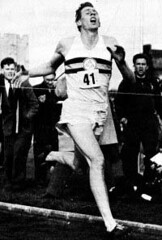‘Blink and you miss a sprint. The 10,000 metres is a lap after lap of waiting. Theatrically, the mile is just the right length – beginning, middle, end, a story unfolding.’
Sebastien Coe
To be truthful I’m not much into running. As I was growing up, the only times I went running was when it was required for during Pendidikan Jasmani(P.E class) and Sukantara (Mass Participation Pre-Sports Day Event) . In secondary school, the furthest I had to run was 1500m, 5 laps around the school field, which first appeared to be quite a gargantuan task for someone who never gone beyond a lap in primary school. For this annual physical test, my whole class would start off at the same time. The faster boys will set the pace, followed by the casual joggers and finally the stragglers who will then fight for the honour of not finishing last. Only much later did I discover the joys of jogging, but that’s another story.
When I recently heard the brief story of the 4 Minute Mile, I was intrigued. It was about a quest for the impossible, to break 4 minutes in running the Mile. Searching the story on the web did not yield much result. Fortunately recently while browsing through the sports section in the local Library, I found the book that had all the answers and much more. The book was aptly titled ‘3:59.4’.
For centuries, men had romanced the Mile, at times flirting near the 4 minute mark, but none had succeeded in conquering the Holy Grail of running. Great runners like Paavo Nurmi, Jack Lovelock, Sydney Wooderson, Gunder Haegg and Arne Andersson had set many records in the 4 Mile Race but their records always fell short of the elusive 4 minutes.
Then on a wet and windy day on
“Ladies and Gentlemen, here is the result of event 9, the one mile race. First, number 41, R.G.Banister of the Amatuer Atheletic Association and formerly of Exeter and Merton Colleges, with a time which is a new meeting and track record, and which, subject to ratification, will be a new English Native, British National, British-Allcomers, European, British Empire and World Record. The time is three …”
Pandemonium drowned the rest of the announcement. The long quest for the four-minute mile was over. Time had stopped for Roger Bannister at 3:59.4.
Since that fateful day, in just a short spate of 50 years after the first sub-four minute mile, countless athletes have ran the Mile under 4 minutes. The current world record of 3:43.13 is held by Hicham El Gerrouj. Roger just had paved the way, to make the impossible possible.
*****************
The mile race has always held a special place in the hearts of atheletes and spectators in the English-speaking world. There is magic in the unit of one, in the simple measure of distance rooted deep in
Excerpt from John Byrant’s ‘3:59.4’

No comments:
Post a Comment